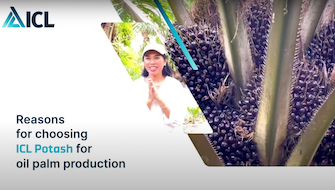Potassium (K) is one of the three essential plant macronutrients, along with nitrogen and phosphorus, that plants need to thrive. Choosing and using potassium-based fertilizers guarantees the availability of potassium in the soil, ready for plants to take up the relatively large amounts of the nutrient they require.
Potassium increases crop yields and improves the quality of agricultural produce while also enhancing the ability of plants to resist diseases, insect attacks, cold and drought stresses, and other adverse conditions. By helping develop strong and healthy root systems, potassium increases the efficiency of the uptake and use of nitrogen and other nutrients.
Potassium and Animal Nutrition
And it is not just plants that benefit. Potassium improves the nutritional quality of products destined for animal nutrition, such as grassland and forage crops, meaning potassium is significant in livestock nutrition.
Many Roles of Potassium in Plants
The importance of potassium stems from its multiple roles in plants:
- Potassium is involved in the activation of more than sixty enzymatic systems in plant cells and in the synthesis of proteins, vitamins, starch, and cellulose which ensure normal plant metabolism, plant growth, and the formation of strong tissues.
- Potassium helps photosynthesis, the process through which the sugars and energy that the plant needs for its development are formed and converted.
- Potassium controls the opening and closing of the leaf stomata, regulating the water status in the plant.
- It is essential in starch formation and the production and translocation of sugars. Potassium is, therefore, of particular value in carbohydrate-rich crops such as sugarcane, potato, and sugar beet.
- The production of starch and sugar in legumes boosted by potassium benefits the symbiotic bacteria living on the roots and thus improves nitrogen fixation.
- Potassium not only increases yields but also enhances crop quality. It improves the nutritional value of grains, tubers, and fruits by increasing the contents of protein and oil in seeds, starch in tubers and seeds, and vitamin C and sugar in fruits.
- With an adequate supply of potassium, cereals produce plump grains and strong stalks, making them resistant to lodging.
- Potassium improves the flavor and color of fruits and increases the size of tubers and fruits. In addition, it increases the resistance to various injuries during storage and transportation, thus extending shelf life.

Symptoms of Potassium Deficiency
Plants deficient in potassium suffer in several ways. Potassium-deficient plants are prone to ‘lodge’ or bend over at ground level, which makes them difficult to harvest. Potassium deficiency also makes plants more susceptible to disease.
Visually, the older leaves appear to have burned edges (scorching), and since potassium is mobile in the plant, the bottom and older leaves show potassium deficiency symptoms first.

Digital Tools
Access calculators to improve nutrient management and boost productivity
3 Brands found

Mini coated nutrition to start your crops
Agromaster® Start Mini is a safe starter fertilizer for all seeded crops, combining ICL’s advanced coating technology with specially selected mini granules. The controlled release of N and P will keep your plants fed in their early stages, without affecting germination and emergence of young plants. With ultra-localized application, close to the seeds, Agromaster® Start Mini boosts rooting and promotes fast establishment of the plants. Coated P-based products improve the availability and uptake of phosphorus by the young root system. Meanwhile the coated nitrogen provides a gradual releases which means that stressful situations, especially in the cold season, will be avoided.
View Brand
Liquid fertilizers with built-in nitrification inhibitor
Nutri Liquid Optima is our range of high-quality, multi-nutrient liquid fertilizers for fertigation with a nitrification inhibitor (DMPP). It keeps nitrogen around in the soil for longer and reduces the risk of leaching. Use it for more efficient fertilization and a higher yield. As it lowers your fertilizer consumption, it has lower environmental impact, making your agricultural practices more sustainable.
View Brand
Superior potash fertilizers
Potash (potassium chloride, or KCl), an essential nutrient for crop nutrition, is the most highly valued and widely used potassium fertilizer in the world, delivering the nutrient to the crop efficiently. ICL’s potash fertilizers are superb sources of potassium, produced at our environmentally friendly production sites. Our unique Dead Sea production site uses a natural evaporation process to produce potash. This process enables us to manufacture premium, high-quality potash fertilizers with a significantly lower carbon footprint than alternative products. For organic producers, there is more good news. ICL’s potash fertilizers are approved as inputs for organic farming under European regulation EU 2018/848, with FiBL, ECOCERT, and INTERECO all providing organic certification. In addition, ICL’s professional agronomic and technical teams are on hand to provide our customers with advice and support to ensure optimum potassium nutrition.
View Brand58 Products found
43 Resources found














































